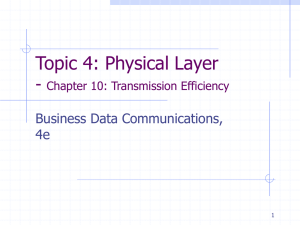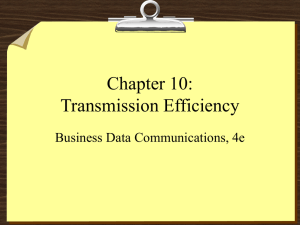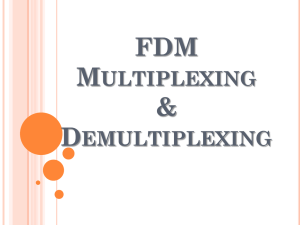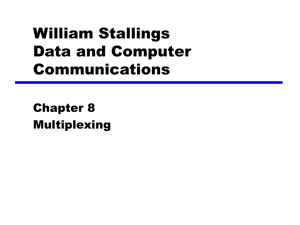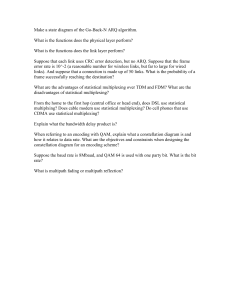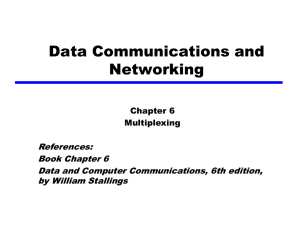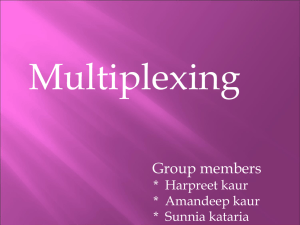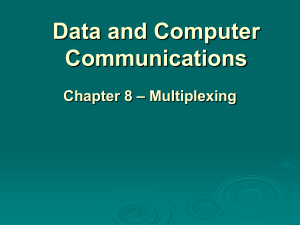Business Data Communications 6e
advertisement
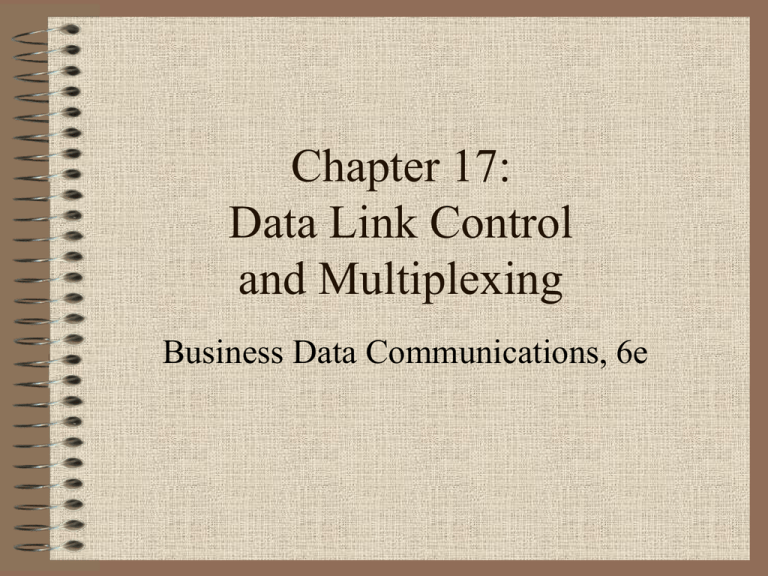
Chapter 17: Data Link Control and Multiplexing Business Data Communications, 6e Data Link Control Module • Data Link control protocol regulates the flow of data • Frame is supplemented with control bits to allow reliable data delivery 2 Flow Control • Necessary when data is being sent faster than it can be processed by receiver • Prevents buffers from overflowing • Computer to printer is typical setting • Can also be from computer to computer, when a processing program is limited in capacity 3 Error Control • Two types of errors – Lost frame – Damaged frame • Automatic Repeat reQuest (ARQ) – – – – Error detection Positive acknowledgment Retransmission after time-out Negative acknowledgment and retransmission 4 High-Level Data Link Control • On transmitting side, HDLC receives data from an application, and delivers it to the receiver on the other side of the link • On the receiving side, HDLC accepts the data and delivers it to the higher level application layer • Both modules exchange control information, encoded into a frame 5 HDLC Frame Structure • Flag: Used for synchronization. 01111110, at start and end • Address: secondary station (for multidrop configurations) • Information: the data to be transmitted • Frame check sequence: 16- or 32-bit CRC • Control: purpose or function of frame – Information frames: contain user data – Supervisory frames: flow/error control (ACK/ARQ) – Unnumbered frames: variety of control functions 6 HDLC Operation • Initialization: S-frames specify mode and sequence numbers, U-frames acknowledge • Data Transfer: I-frames exchange user data, S-frames acknowledge and provide flow/error control • Disconnect: U-frames initiate and acknowledge 7 HDLC Frame Structure 8 HDLC Initialization 1. Signals the other side that initialization is requested 2. Specifies which of three modes is requested (primary or peer connection) 3. Specifies whether 3 or 7-bit sequence numbers are used 9 HDLC Data Transfer • Data is transmitted in I frames; starting with sequence number 0. • N(S) and N(R) fields are sequence numbers that support flow control and error control. • S frames are also used for flow control and error control. 10 HDLC Disconnect • HDLC issues a disconnect by sending a Disconnect (DISC) frame. • The other side acknowledges the disconnect by replying with a UA. 11 HDLC Examples 12 Multiplexing • Shared use of communication capacity • Commonly used in long-haul communications, on high-capacity fiber, coaxial, or microwave links • Multiplexer combines data from n input lines and transmits over a higher-capacity data link • Demultiplexer accepts multiplexed data stream, separates the data according to channel, and delivers them to the appropriate output lines. 13 Multiplexing 14 Motivations for Multiplexing • The higher the data rate, the more costeffective the transmission facility – cost per kbps declines with an increase in the data rate of the transmission facility – cost of transmission and receiving equipment, per kbps, declines with increasing data rate. • Most individual data communicating devices require relatively modest data rate support 15 Frequency Division Multiplexing (FDM) • Requires analog signaling & transmission • Total bandwidth = sum of input bandwidths + guardbands • Modulates signals so that each occupies a different frequency band • Standard for radio broadcasting, analog telephone network, and television (broadcast, cable, & satellite) 16 FDM and TDM 17 Wavelength Division Multiplexing • Form of FDM used when multiple beams of light at different frequencies are transmitted on the same optical fiber. • Uses the same architecture as FDM • Most WDM systems operate in the 1550-nm range. In early systems, 200 MHz was allocated to each channel, but today most WDM systems use 50-GHz spacing • dense wavelength division multiplexing (DWDM) connotes the use of more channels, more closely spaced (≤200Ghz), than ordinary 18 WDM FDM Example: ADSL • ADSL uses frequency-division modulation (FDM) to exploit the 1-MHz capacity of twisted pair. • Asymmetric because ADSL provides more capacity downstream (from the carrier’s central office to the customer’s site) than upstream (from customer to carrier). 19 3 Elements of ADSL Strategy • Reserve lowest 25 kHz for voice, known as POTS • Use echo cancellation or FDM to allocate a small upstream band and a larger downstream band • Use FDM within the upstream and downstream bands, using “discrete multitone” 20 Echo Cancellation • Entire frequency band for the upstream channel overlaps the lower portion of the downstream channel • Advantages – The higher the frequency, the greater the attenuation. – More flexible for changing upstream capacity • Disdvantages – Need for echo cancellation logic on both ends of line 21 ADSL Channel Configuration 22 Discrete Multitone (DMT) • Uses multiple carrier signals at different frequencies, sending some of the bits on each channel. • Transmission band (upstream or downstream) is divided into a number of 4-kHz subchannels. • Modem sends out test signals on each subchannel to determine the signal to noise ratio; it then assigns more bits to better quality channels and fewer bits to poorer quality channels. 23 Synchronous Time-Division Multiplexing (TDM) • Used in digital transmission • Requires data rate of the medium to exceed data rate of signals to be transmitted • Signals “take turns” over medium • Slices of data are organized into frames • Time slots are pre-assigned to sources and are fixed • Time slots are transmitted regardless of data • Used in the modern digital telephone system – US, Canada, Japan: DS-0, DS-1 (T-1), DS-3 (T-3), ... – Europe, elsewhere: E-1, E3, … 24 Synchronous TDM Example 25 Digital Carrier Systems • Long-distance carrier system designed to transmit voice signals over high-capacity transmission links (e.g. optical fiber, coaxial cable, and microwave) • Evolution of these networks to digital involved adoption of synchronous TDM transmission structures 26 DS-1 Transmission Format • Multiplexes 24 channels • Voice transmission – Frame contains 8 bits per channel plus a framing bit for 24 8 + 1 = 193 bits – Signal digitized with PCM at 8000 samples/second – Data rate of 8000 193 = 1.544 Mbps • Data transmission – 23 channels of data are provided – Last channel position reserved for special sync byte • Mixed voice and data uses all 24 channels 27 DS-1 Transmission Format 28 T-1 Facilities • Transmission facilities supporting DS-1 • Often used for leased dedicated transmission between customer premises – – – – – Private voice networks Private data network Video teleconferencing High-speed digital facsimile Internet access 29 SONET/SDH • SONET (Synchronous Optical Network) is an optical transmission interface proposed by BellCore and standardized by ANSI. • Synchronous Digital Hierarchy (SDH), a compatible version, has been published by ITU-T • Specifications for taking advantage of the highspeed digital transmission capability of optical fiber. 30 SONET/SDH Features • Defined hierarchy of standardized digital data rates • The lowest level is 51.84 Mbps • Basic building block is the STS-1 frame; which can be viewed as a matrix of 9 rows of 90 octets; the first 3 columns are overhead octets, the remainder is payload 31 SONET/SDH Signal Hierarchy 32 SONET/SDH Frame Formats 33
